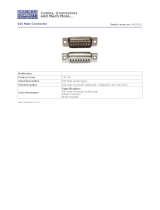
AV3000 AVC Unit Service Manual
TABLE OF CONTENTS
1.
FEATURES...............................................................................................................................................1
2. GENERAL SPECIFICATION ....................................................................................................................1
3. AV MODES ...............................................................................................................................................2
4. AV BOARD DESCRIPTION......................................................................................................................2
4.1. AVC Block Diagram...........................................................................................................................2
4.2. Tuner/Video Chroma (Schematic Sheet 1)........................................................................................2
4.3. Sound/AV3 Control (Schematic Sheet 2) ..........................................................................................4
4.4. Interface Board (Schematic Sheet 3) ................................................................................................6
4.5. Power Circuit/Level Shifter (Schematic Sheet 4)...............................................................................8
4.6. Micro-controller (Schematic Sheet 5) ................................................................................................9
4.7. COMB Filter/SVHS Output (Schematic Sheet 6).............................................................................10
4.8. SCART/FC-MSC Connection (Schematic Sheet 7).........................................................................11
5. AVC POWER BOARD DESCRIPTION...................................................................................................12
5.1. AVC Power Board Block Diagram...................................................................................................12
5.2. Switching Regulator, Controller and Power MOS FET....................................................................12
5.3. DC+5V Switching Regulator Module...............................................................................................13
5.4. Photo-coupler...................................................................................................................................13
5.5. Switching Regulators.......................................................................................................................13
5.6. DC+5V Series Regulator .................................................................................................................14
5.7. Connectors.......................................................................................................................................14
6. FC4 BOARD DESCRIPTION..................................................................................................................15
6.1. FC4 Board Block Diagram...............................................................................................................15
7. PINOUT DATA........................................................................................................................................16
7.1. Micro-controller Pin-out (SDA5550).................................................................................................16
7.2. AVC-PDP Connectors .....................................................................................................................17
7.3. FC4 Connectors...............................................................................................................................18
8. SERVICING INFORMATION..................................................................................................................21
8.1. Diagnostics ......................................................................................................................................21
8.2. AV Board Troubleshooting...............................................................................................................21
8.3. Power Board Troubleshooting.........................................................................................................22
8.4. Service Menu Data ..........................................................................................................................23
9. UNIT WIRING DIAGRAM .......................................................................................................................36
9.1. AVC Unit ..........................................................................................................................................36
10. ASSEMBLY DIAGRAM...........................................................................................................................37
10.1. AVC Unit.......................................................................................................................................37
11. SCHEMATIC DIAGRAMS.......................................................................................................................38
11.1. AV Board Schematics ..................................................................................................................38
11.2. Power Board.................................................................................................................................45
11.3. Control Board ...............................................................................................................................46
11.4. Mains Switch, Filter, Speaker & LED Boards...............................................................................47
12.
PCB LAYOUT DIAGRAMS.....................................................................................................................48
12.1.
AV Board......................................................................................................................................48
12.2. Power Board.................................................................................................................................49
12.3. Control, Speaker, Filter & LED Boards ........................................................................................50
13.
PARTS LISTS .........................................................................................................................................51
13.1.
AV3000 Assembly Parts List........................................................................................................51
13.2. AV Board Parts List......................................................................................................................51
13.3. Power Board Parts List ................................................................................................................51
13.4. Control Board Parts List...............................................................................................................51
iii




























